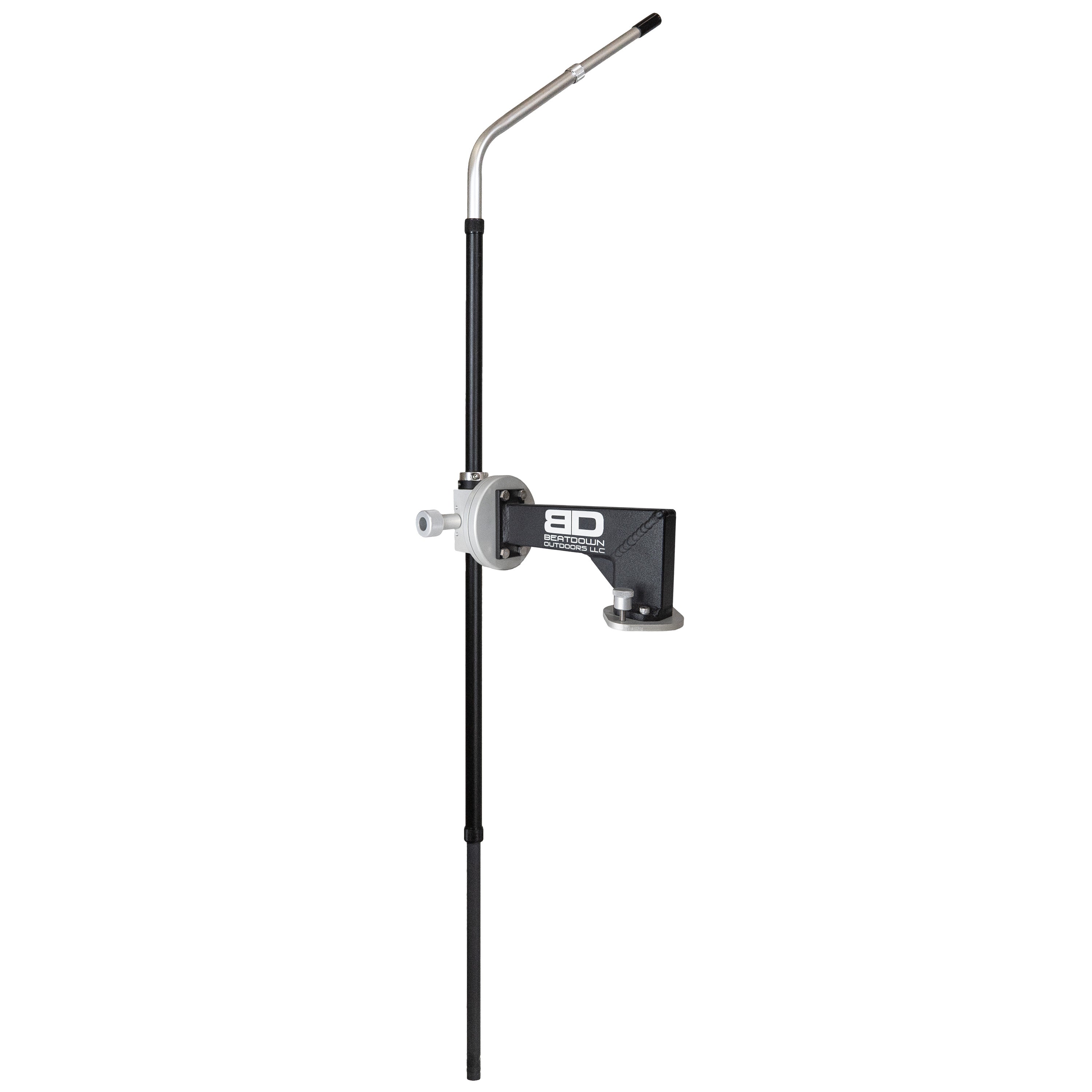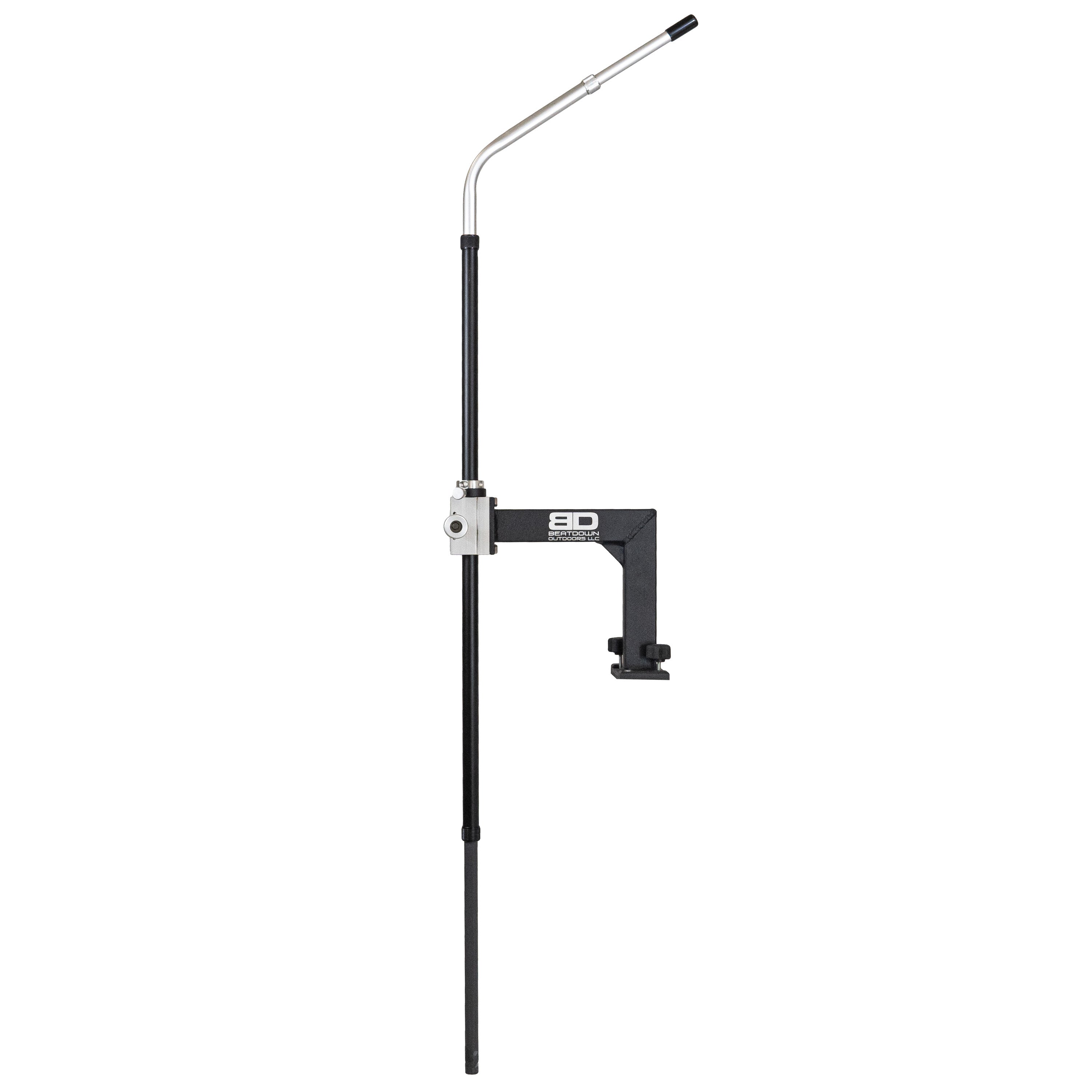As technology advances in fishing, tools like Garmin’s Livescope have become essential for serious anglers. By providing real-time sonar imaging, Livescope helps identify fish and structures with incredible detail, giving you the edge to make every fishing trip successful.
But to get the best results from this advanced system, it’s crucial to understand the best place to mount your Livescope pole on your boat. Depending on your boat type, target species, and fishing style, the location of your Livescope pole can impact everything from ease of use to accuracy.
This guide will cover the three main mounting locations for a Livescope transducer pole—the bow, console, and stern/transom. We’ll explore the pros and cons of each position and recommend which might be best based on various boat types and fishing scenarios. Plus, we’ll look at two top transducer pole options offered by BeatDown Outdoors to help you get set up for maximum efficiency and durability.
Understanding the Importance of Livescope Pole Placement
Where you mount your Livescope pole affects how you interact with the technology and its effectiveness in locating fish. With a Livescope, you’re working with high-definition imaging, so placement that allows for easy adjustment, visibility, and control is critical. Different anglers will have different preferences, but generally, the location should reflect how you intend to fish—whether actively from the front, scouting from the middle, or side scanning from the back.
A properly placed Livescope pole can improve accessibility and make time on the water more productive. Factors like visibility from the driver’s seat, potential interference from other electronics, and accessibility for quick adjustments all come into play.
Bow Mount: For Active Fishing and Trolling Motor Sync
Advantages of Bow Mounting
Mounting your Livescope pole at the bow is ideal for anglers who spend most of their time actively fishing from the front of the boat. This setup works well for bass and crappie anglers who often position themselves at the bow, allowing them to control both the trolling motor and Livescope simultaneously. The bow position is excellent for active fishing, where precision is crucial, and the angler needs immediate, responsive feedback to locate and cast at fish.
Having your Livescope pole on the bow allows for fast and smooth adjustments without disrupting your position or view. This is especially helpful when working around vegetation and submerged timber or scanning large basins for roaming fish. This spot keeps you near the action and lets you watch the screen in real-time without any hassle.
Disadvantages of Bow Mounting
While the bow is ideal for active fishing, it can be less efficient if you want to cover a wide area quickly. Moving large distances is slower with the trolling motor, making scanning or searching over long stretches of open water more challenging. If you fish from the back of the boat or focus more on trolling than casting, bow mounting may not be the best choice.
Best Boat Types and Species
Bow mounting works exceptionally well on Bass Boats, Jon Boats, and smaller Deep V Boats. It’s popular among bass, crappie, and panfish anglers who rely on pinpoint accuracy to find structure and fish.
Console Mount: For Scanning While Driving and Efficient Searching
Advantages of Console Mounting
The console position is popular among anglers who use their Livescope primarily for scouting and searching or like to drop a bait quickly in an area to see if they are biting. By mounting the Livescope pole near the console, you can use the system effectively while the big motor is running, making it easier to cover large areas in less time. This setup is ideal for marking spots, drop-offs, and other points of interest for later targeting, which is valuable for anglers focused on deep or open-water species.
Console mounting also offers a central location for Livescope monitoring, which allows you to adjust positioning without leaving the driver’s seat.
Disadvantages of Console Mounting
While console mounting is great for scanning large areas, it can be inconvenient if you’re actively fishing. The Livescope pole is farther from your casting area, so adjustments may require you to move back to the console often. It’s also less practical if you prefer to stand at the bow or stern while fishing.
Best Boat Types and Species
Console mounting is common on larger Deep V boats or certain multi-species setups. It’s a popular choice for walleye, muskie, or open-water anglers who rely on sonar scanning more than active casting.
Transom/Stern Mount: For Rear-Focused Fishing and Side Scanning
Advantages of Stern/Transom Mounting
Mounting your Livescope pole on the stern is ideal for anglers who fish from the back of the boat, such as muskie or pike anglers who prefer to cast from the rear. The transom mount also allows for effective side scanning while driving, which is helpful for locating schools of fish or submerged structure.
This setup keeps the bow area clear, which some anglers prefer for a less cluttered fishing environment. It’s also convenient for those using the Livescope to locate specific features while steering from the back.
Disadvantages of Stern/Transom Mounting
Transom mounting may limit access if you’re fishing from the bow, making it harder to adjust while casting. It can also interfere with other rear-mounted electronics or hardware, so spacing and compatibility should be considered.
Best Boat Types and Species
This setup works best on larger boats and multi-species rigs, especially those used for trolling or open-water fishing. It’s popular among muskie, catfish, and pike anglers.
Boat-Specific Recommendations

Deep V Boats
Deep V boats are versatile, with room to accommodate almost any mounting position. Console or transom mounting is often preferred on these larger boats, allowing for efficient scanning. These boats are commonly used for walleye, muskie, and pike, which are often utilized in open waters.
Jon Boats
Space can be limited on jon boats, so compact solutions like bow or transom mounting work best. These boats are often used by bass and crappie anglers, who benefit from bow mounting for active casting.
Bass Boats
Bass boats typically have Livescope poles mounted at the bow, allowing for active fishing while running the trolling motor. This setup is widely used in bass tournaments, where anglers are focused on specific structures and need instant feedback. Instead of a pole, anglers will mount the Livescope transducer directly to the trolling motor.
Choosing the Best Mounting Solution for Your Needs: BeatDown Outdoors’ Transducer Pole Options
Choosing the right transducer pole is as essential as deciding on the mounting location to achieve the ideal setup for your fishing needs. BeatDown Outdoors offers two reliable options that cater to various fishing styles: the BreakAway Transducer Pole and the Fixed Transducer Pole.

BreakAway Transducer Pole
The BreakAway Transducer Pole by BeatDown Outdoors is engineered for flexibility and protection. Its unique breakaway design allows it to pivot if it hits an obstacle, protecting both the pole and the transducer from damage. This feature makes it perfect for anglers who fish in areas with heavy cover or submerged structures.
Best for: Anglers who frequently encounter obstacles like stumps or rocks fishing around dense cover.
Fixed Transducer Pole
The Fixed Transducer Pole offers stability and simplicity for anglers focused on consistent scanning. It keeps the Livescope in a steady position, which is excellent for open-water fishing where constant adjustments are not necessary. This durable, straightforward design is perfect for anglers who prioritize stability.
Best for: Anglers who need steady imaging over open water and those who don’t require frequent repositioning.
Conclusion
Selecting the right Livescope pole mounting location depends on your fishing style, target species, and the type of boat you use. Mounting on the bow is excellent for active casting, console mounting is ideal for efficient searching, and transom mounting provides flexibility for rear-focused anglers.
Paired with the right BeatDown Outdoors Transducer Pole, your Livescope setup can help you find fish faster.




